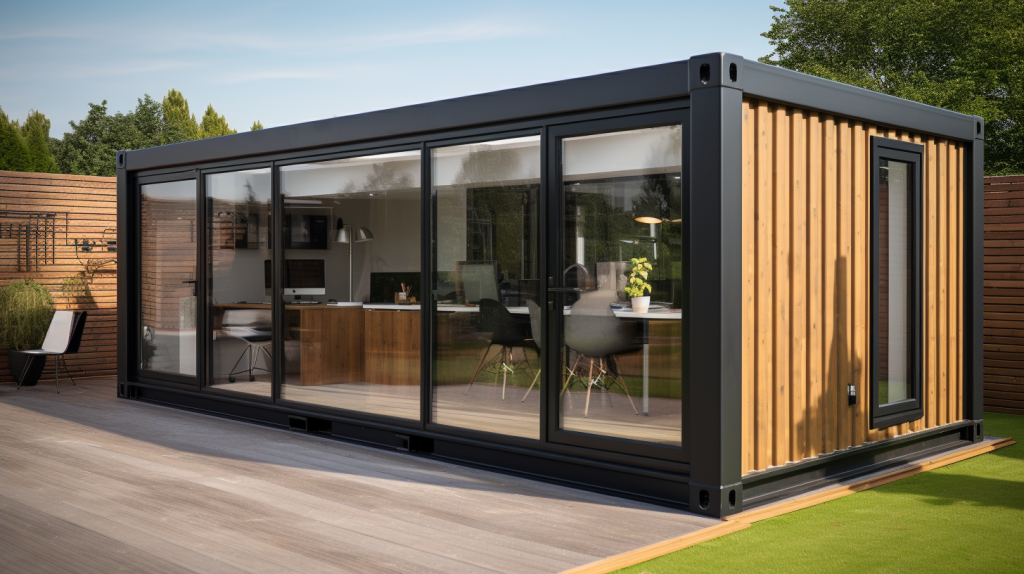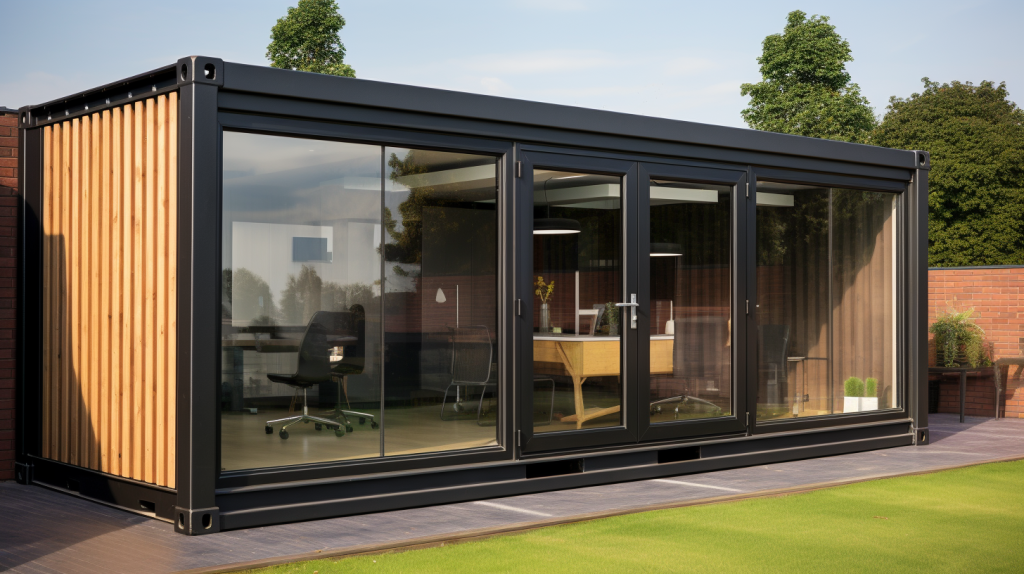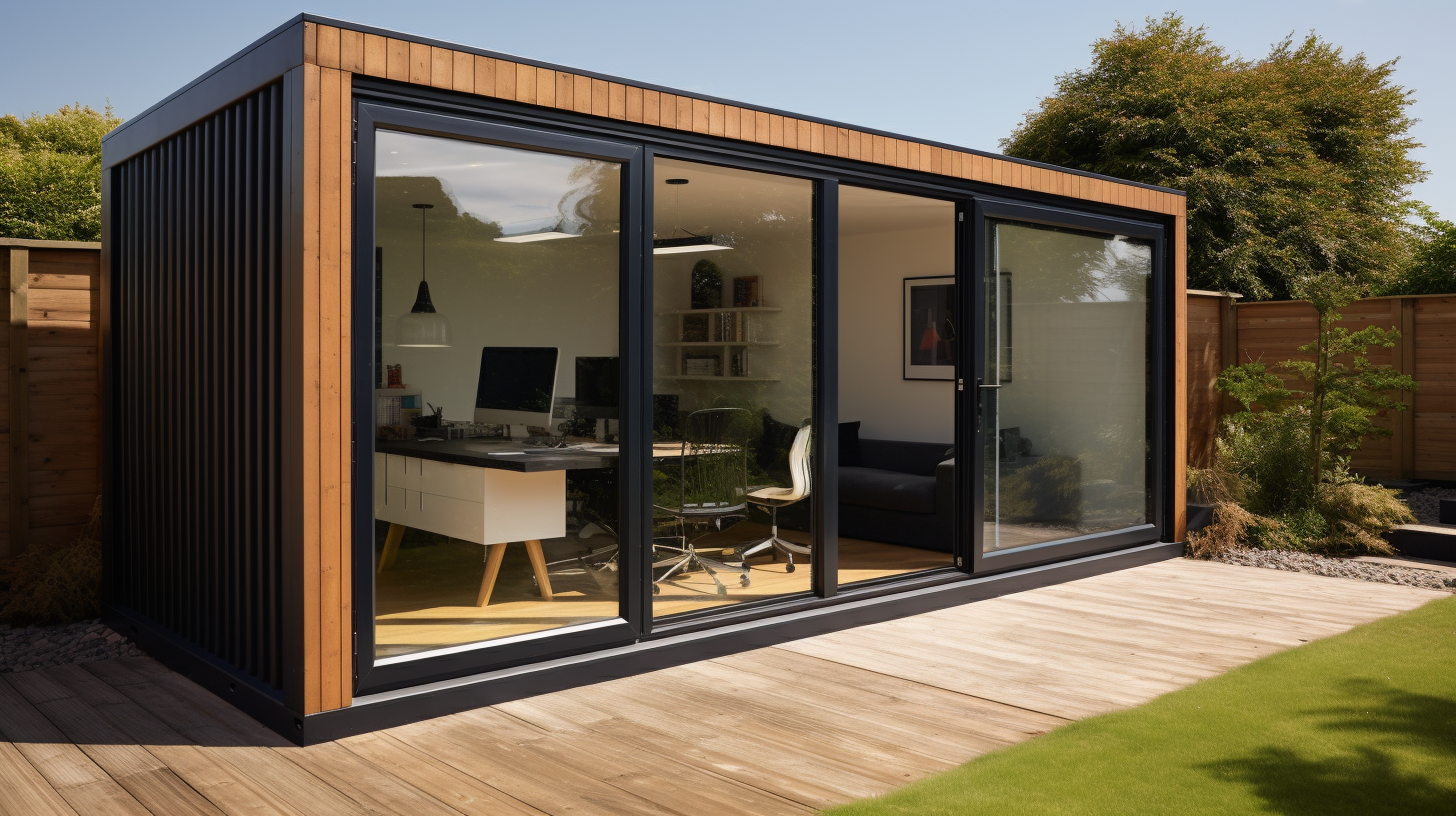You’re ready to create a unique workspace, and we’re here to guide you.
Building your own shipping container office isn’t as daunting as it seems. You’ll learn about choosing the right container, design considerations, modification processes, essential features, legalities, safety aspects, and budgeting.
Let’s delve into these technical details so you can kickstart your project with confidence!
Understanding the Basics of Shipping Container Offices
Before you dive in, it’s crucial that you understand the basics of shipping container offices. Container longevity is a key factor to consider. On average, these structures can last up to 25 years with minimal maintenance, giving your project durability and long-term value.
Eco friendly aspects are another essential element. The conversion of a used shipping container into an office reduces waste and requires fewer construction materials than traditional buildings. However, there are inherent space limitations. Standard containers are either 20 or 40 feet long, which may restrict your design.
Container sourcing should be approached carefully. It’s recommended that you choose a reputable dealer who can provide quality assurances and advice on selecting the right container for your needs.
Lastly, consider weather resilience. Containers are designed to withstand harsh maritime conditions but adapting them for comfortable year-round use requires careful insulation planning and installation of HVAC systems.
Understanding these fundamental aspects will help guide your decision-making process as you embark on this exciting project – transforming a humble shipping container into a sustainable, functional workspace.
Choosing the Right Shipping Container
You’ll need to consider various factors when picking the right metal box for your workspace. One of these is container longevity. It’s crucial to source a shipping container that’s built to last, especially if you’re planning a long-term project. Check the container’s history, paying close attention to its usage and maintenance records.
Size relevance is another aspect you can’t ignore. The size of your shipping container should align with the space requirements of your project. Remember, it needs to comfortably accommodate all your office equipment while still offering enough room for easy movement.
Rust prevention also plays a significant role in your choice. Look for containers made from COR-TEN steel, known for its superior rust resistance properties.
Insulation options are equally imperative when choosing the right shipping container office. Depending on your location’s climate conditions, you might want to consider insulation materials that offer thermal control and moisture protection.
Lastly, pay keen attention to where you’re sourcing the container from. Reputable dealers often provide containers that meet industry standards and have necessary certifications in place. Making an informed decision will ensure you get the best value out of your investment in setting up a shipping container office.
Designing Your Shipping Container Office

Once you’ve selected the right metal box, it’s time to start thinking about how to design your workspace. You need to strike a balance between aesthetic appeal and functionality emphasis. For materials, focus on eco-friendly options. Consider reclaimed wood for desks or bamboo flooring; both are durable and sustainable.
Next, think of space utilization. Optimize every square inch of your shipping container office. Implement a layout that enhances workflow and productivity — L-shaped or U-shaped workstations can be excellent choices.
Lighting options play an essential role in workspace design too. Natural light boosts mood and efficiency, so aim to maximize it with large windows or skylights if feasible. For artificial lights, LEDs are your best bet due to their energy efficiency and wide range of color temperatures.
Lastly, don’t neglect the exterior aesthetics of your container office; this is what will create that first impression. Choose paints that resist rust but also complement the surrounding environment for a harmonious blend with nature.
The Process of Modifying a Shipping Container
Modifying a metal box into a workspace involves several essential steps. First, you need to make cut-outs for windows and doors, ensuring that the structural integrity of the container isn’t compromised.
The next step is container insulation, which is vital for maintaining an ideal internal climate. You can choose from options like spray foam or panel insulation, depending on your budget and needs. This will help achieve thermal comfort and reduce energy consumption.
After insulation, you can move on to roof modifications. While preserving the original roof may retain its rugged aesthetics, you also have the option to install a pitched or green roof based on your preference.
Window installations are another crucial aspect of the project. They not only aid in ventilation but also enhance the container’s aesthetics by allowing natural light to seep into your workspace.
Throughout the process, it’s important to maintain a balance between functional utility and visual appeal, without sacrificing either. As you progress with the project, make sure to regularly check if everything aligns with your initial design plan.
With meticulous planning and careful execution, you will successfully transform this steel structure into an exceptional office space.
Essential Features for a Shipping Container Office

There are several key features you’ve got to consider when transforming your steel structure into a functional workspace. Topping the list is container insulation – essential for thermal comfort and energy efficiency. You must select an insulation type, like spray foam or paneling, that suits your geographical location and intended use.
Next, office lighting is crucial. It’s not just about illumination; it’s also about creating an ambience conducive to productivity. Consider combining natural light with LED lights, providing ample brightness without strain on your eyes.
Furniture selection should align with both functionality and aesthetics. Invest in ergonomic chairs and desks to enhance comfort during long working hours. For aesthetics, choose pieces that match the industrial vibe of the container yet offer a touch of warmth.
Tech infrastructure is another vital aspect. You’ll need high-speed internet connectivity, power outlets at convenient points for devices like computers and printers, as well as efficient cooling systems to keep tech equipment from overheating.
Lastly, never overlook container aesthetics – after all, this will serve as your brand image too! Aim for a clean look with minimalistic touches – but don’t forget that pop of color for creative appeal.
Legal and Safety Considerations
It’s crucial to address legal and safety considerations when setting up your workspace in a steel structure. To do this, you must understand and comply with the zoning regulations in your area. These rules determine where certain types of buildings can be erected. It’s important to ensure that your shipping container office aligns with the zoning requirements.
Next, focus on permit acquisition. You’ll need permission from local authorities before beginning construction or renovation work on your steel structure. The process often involves submitting detailed plans for review and paying associated fees.
Consider fire safety as well, which is paramount in any workspace but particularly so in a steel structure. Install fire extinguishers, smoke detectors, and plan for clear escape routes.
Don’t overlook structural integrity; it ensures that your office can withstand environmental stresses like wind loads and seismic activities without collapsing. A certified engineer should evaluate this aspect before you proceed.
Lastly, adhere to accessibility standards outlined by law such as the Americans with Disabilities Act (ADA). This includes installing ramps or elevators where necessary to accommodate individuals with disabilities. Remember, meeting these legal and safety requirements isn’t just about compliance – it’s about creating a safe, inclusive environment for everyone who uses your space.
Costs and Budgeting for Your Shipping Container Office
You’re going to need to carefully consider your expenses and set a realistic budget when planning this unique workspace. This includes not only the initial purchase of the shipping container, but also any modifications you want to make, as well as ongoing maintenance expenses.
Financing options can be complex. You’ll want to explore all possible avenues, from traditional bank loans to crowdfunding campaigns or even personal savings. And don’t overlook potential hidden costs like delivery charges for the container or permit fees for construction and placement.
Maintenance expenses could become a significant part of your budget over time, so remember to factor in things like regular painting to prevent rust, HVAC upkeep, and general wear-and-tear repairs.
In order to avoid common budgeting mistakes, it’s crucial you research cost-effective solutions thoroughly before committing. For example, investing in proper insulation upfront may seem costly, but it can save on heating and cooling costs long term.
Ultimately, careful financial planning will ensure that your shipping container office is both a functional workspace and a smart investment. Remember – an informed approach now will save you headaches down the line!
Frequently Asked Questions
What Are the Potential Drawbacks of Using a Shipping Container as an Office?
You might face insulation challenges, increased noise levels, and potential safety concerns when using a shipping container as an office. There are also permitting issues to navigate and rust development to prevent.
Can a Shipping Container Office Be Moved to a New Location After It’s Built?
Yes, you can move your shipping container office. However, relocation costs may apply. Also, permit requirements for the new location and maintaining structural integrity during transit are concerns. Office customization might affect container sourcing too.
How Environmentally Friendly Is a Shipping Container Office Compared to Traditional Office Buildings?
When comparing green aspects, your shipping container office outshines traditional buildings. You’re incorporating solar power, LED lighting, sustainable materials like green insulation, and rainwater harvesting- all promoting a lower environmental impact.
Can a Shipping Container Office Be Expanded by Adding More Containers in the Future?
Yes, you can expand your office by adding more containers in the future. Consider container aesthetics, interior design, insulation, security measures, and maintenance costs when planning your expansion project.
How Long Does It Typically Take to Build a Shipping Container Office From Start to Finish?
Depending on container customization, space planning, material costs, weather resistance and permit requirements, it can take you 2-3 months to fully construct a shipping container office from start to finish.
Conclusion

So, you’ve navigated the ins and outs of building a shipping container office. You’ve selected your container, designed it to suit your needs, and modified it accordingly.
You’ve also ensured its legal and safety compliance, with careful budgeting and attention to essential features.
Now, you’re well on your way to making this project a success. Remember, every detail matters in this process – keep focused.
Get ready to enjoy your new workspace!
